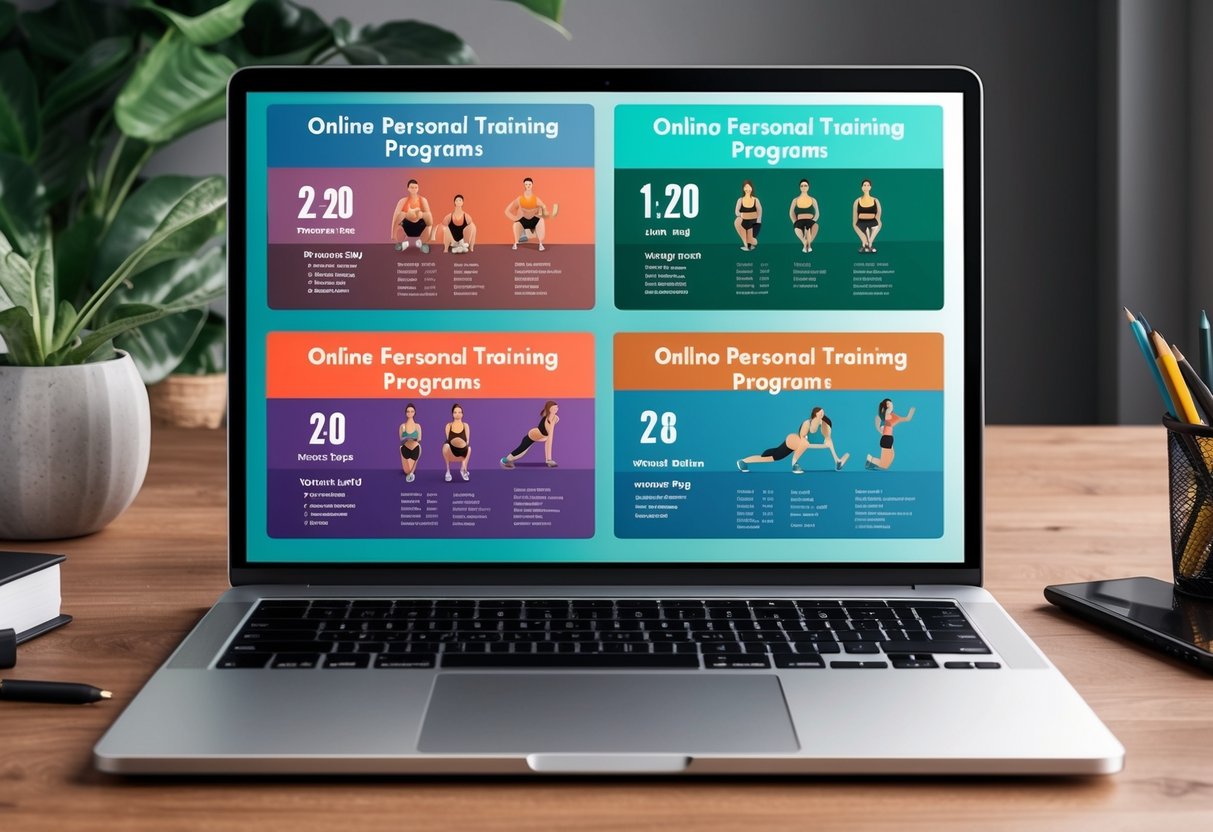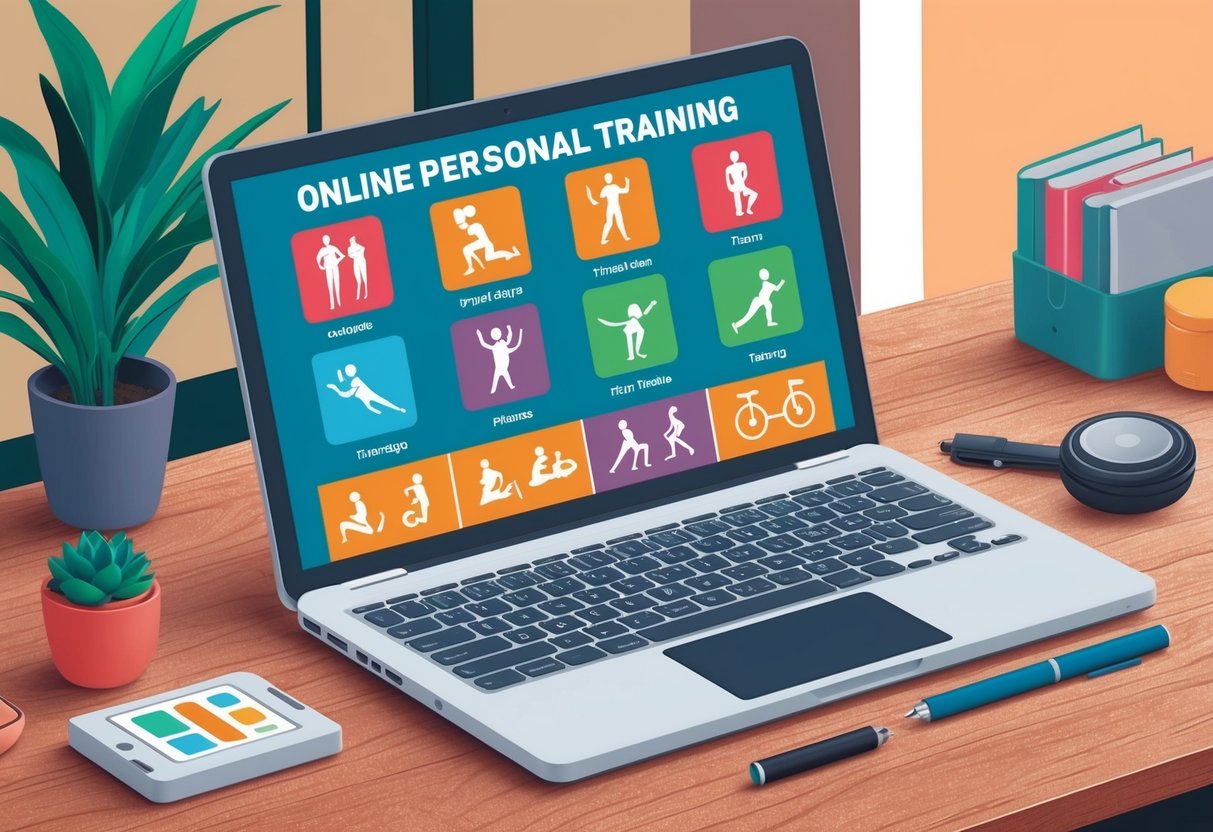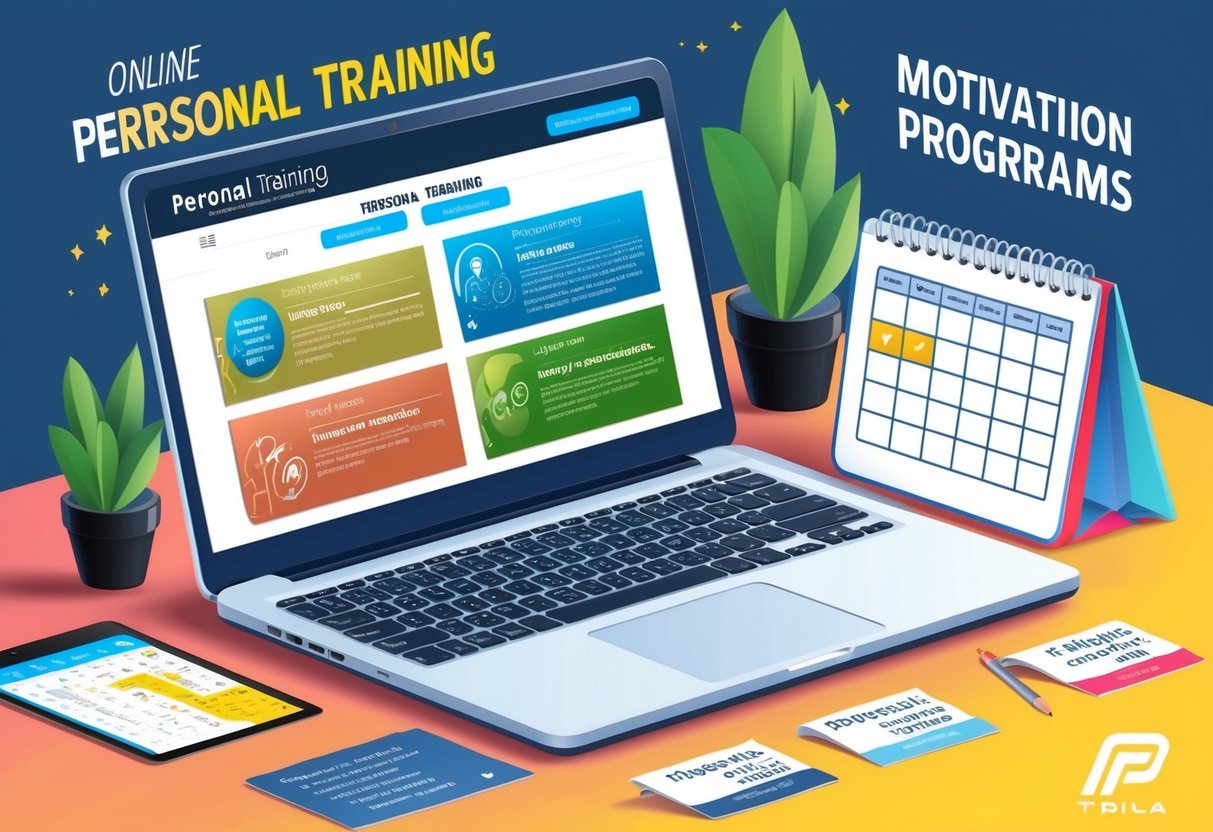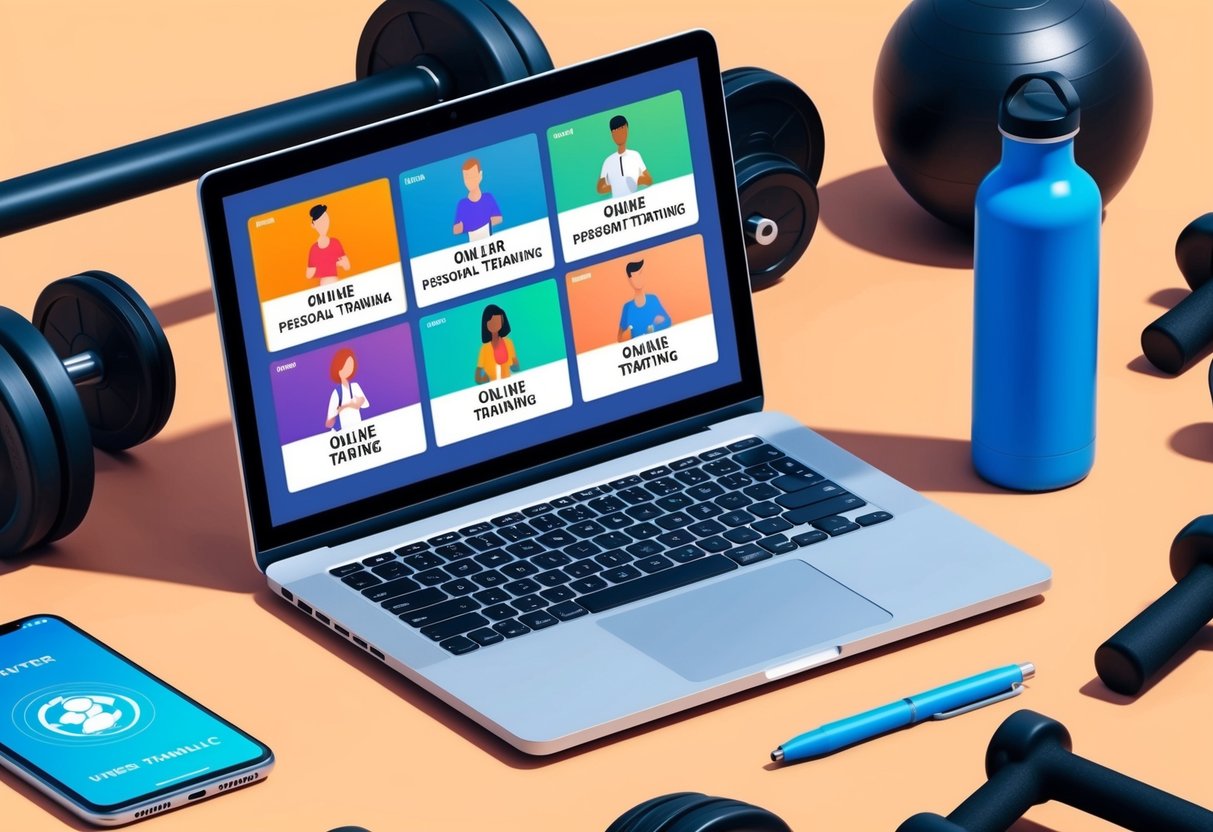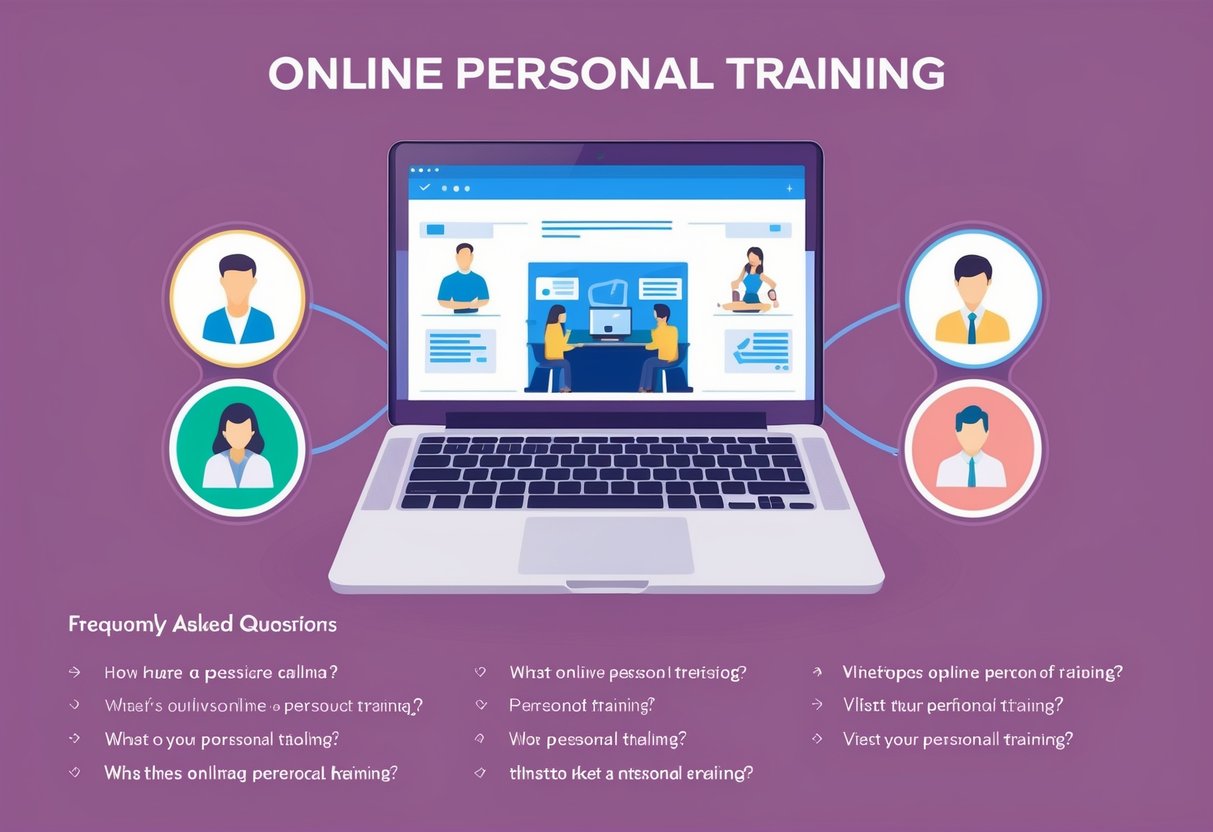Online personal training has revolutionized the fitness industry. It offers flexible and accessible options for achieving your health goals. With various types available, you can find a program that fits your schedule, preferences, and fitness level.
Choosing the right type of online personal training can significantly impact your motivation, progress, and overall success in reaching your fitness objectives.

Whether you’re a beginner or an experienced fitness enthusiast, online training provides personalized guidance and support from expert trainers.
You can access workouts, nutritional advice, and progress tracking tools from the comfort of your home or while traveling.
Popular Posts
- Massage Gun vs. Foam Roller: Which Recovery Tool Reigns Supreme?
- 27 Best Calisthenics Exercises for Full-Body Strength and Fitness
- 10 HIIT Workouts for Busy Professionals: Max Fitness, Min Time
- Good Posture Working from Home: Optimize Your Workspace to Prevent Discomfort and Health Issues
- The Best Crossfit Exercises for Full-Body Conditioning
This convenience allows you to maintain consistency in your fitness routine, regardless of your location or time constraints.
Key Takeaways
- Online personal training offers flexibility and accessibility for achieving fitness goals
- Different types of online training cater to various preferences and learning styles
- Personalized guidance and support from expert trainers enhance motivation and progress
Understanding Online Personal Training

Online personal training brings fitness guidance directly to your digital devices. It offers flexibility and personalized programs tailored to your goals and schedule.
The Rise of Virtual Fitness
Virtual fitness has exploded in popularity, driven by technological advancements and changing lifestyles.
Fitness apps and online platforms now provide access to expert trainers from anywhere.
You can join live classes, follow pre-recorded workouts, or receive customized plans.
Many apps offer features like progress tracking, nutrition guidance, and community support.
This digital approach allows you to maintain consistency in your fitness routine, regardless of location or time constraints.
Benefits of Training Online
Online personal training offers convenience and affordability. You can work out on your own schedule without commuting to a gym.
Virtual coaching often costs less than in-person sessions, making it more accessible.
You gain access to a wider pool of trainers, potentially finding someone who specializes in your specific goals.
Online programs frequently provide detailed workout logs and progress metrics, helping you stay motivated and accountable.
Fitness apps allow you to carry your workout plan in your pocket, making it easier to stay on track even when traveling.
Choosing an Online Personal Trainer
When selecting an online personal trainer, consider their qualifications and experience. Look for certifications from reputable organizations and check client testimonials.
Evaluate the trainer’s communication style and availability.
Some offer real-time video sessions, while others provide feedback through messaging or email.
Ensure their approach aligns with your preferences and needs.
Review the technology and tools they use. A user-friendly platform enhances your experience and makes it easier to follow the program.
Consider whether you prefer a more structured plan or a flexible approach that adapts to your progress.
Evaluating Different Types of Online Personal Training
Online personal training offers diverse options to suit different fitness goals and preferences. Each type has unique features that can enhance your workout experience and results.
1-on-1 Personal Training
Virtual one-on-one sessions provide personalized attention from certified personal trainers.
You’ll receive customized workout plans and real-time feedback through video calls. This option is ideal if you want focused guidance and accountability.
Benefits include:
- Tailored exercises for your specific goals
- Immediate form corrections
- Flexible scheduling
Drawbacks:
- Higher cost compared to other options
- Requires reliable internet connection
- Limited equipment availability at home
Group Training Sessions
Online group classes bring together fitness enthusiasts in a virtual setting. You’ll join live-streamed workouts led by experienced trainers, fostering a sense of community and motivation.
Key features:
- Variety of class types (HIIT, yoga, strength training)
- Lower cost than individual sessions
- Social interaction with other participants
Potential downsides:
- Less personalized attention
- Fixed class schedules
- Varying skill levels among participants
Specialized Training Programs
These programs cater to specific fitness goals or demographics. You might find options for weight loss, muscle gain, prenatal fitness, or rehabilitation.
Advantages:
- Focused approach to targeted outcomes
- Expert guidance in niche areas
- Structured progression plans
Considerations:
- May require specific equipment
- Limited flexibility in workout variety
- Potentially higher cost for specialized expertise
Hybrid Training Options
Hybrid models combine elements of different training types. You could have a mix of one-on-one sessions, group classes, and self-guided workouts.
Benefits:
- Variety in training styles
- Balance of personalization and community
- Cost-effective compared to purely individual training
Aspects to consider:
- Requires self-motivation for independent workouts
- Potential for information overload
- Scheduling complexity with multiple components
Key Components of Effective Online Training
Successful online personal training programs incorporate several essential elements to help clients achieve their fitness goals. These components work together to provide a comprehensive and tailored experience.
Customized Workout Plans
Personalized exercise routines form the backbone of effective online training.
Trainers assess your fitness level, goals, and limitations to create tailored workouts.
These plans adapt as you progress, ensuring continued challenge and growth.
Your program may include:
- Strength training exercises
- Cardiovascular activities
- Flexibility work
- Rest and recovery days
Trainers often provide video demonstrations or written instructions for proper form and technique. This customization helps prevent injuries and maximizes results by targeting your specific needs and preferences.
Nutrition and Meal Planning
A well-designed meal plan complements your workout routine.
Online trainers often offer nutritional guidance tailored to your goals, dietary preferences, and lifestyle.
Key aspects of nutrition planning include:
- Calorie and macronutrient recommendations
- Meal ideas and recipes
- Grocery shopping lists
- Strategies for dining out
Your meal plan may adjust based on your progress and changing needs.
Some trainers use apps or software to help you track your food intake and make informed choices.
Tracking and Accountability
Progress monitoring is crucial for staying motivated and making adjustments.
Effective online training programs incorporate various tracking methods:
- Regular weigh-ins or measurements
- Progress photos
- Strength and endurance tests
- Workout logs
Many trainers use apps or online platforms for easy data input and visualization.
These tools help you see your improvements over time and stay accountable to your goals.
Communication and Support
Regular interaction with your trainer is vital for success in online personal training.
Effective programs offer multiple communication channels:
- Email or messaging systems
- Video calls for form checks or consultations
- Forums or group chats for peer support
Trainers provide feedback on your progress, answer questions, and offer motivation.
Some programs include scheduled check-ins to discuss your achievements and challenges. This ongoing support helps you stay committed to your fitness journey and overcome obstacles.
Choosing the Right Platform and Trainer
Selecting an online personal trainer and platform requires careful consideration. Focus on key factors to ensure you find the best fit for your fitness goals and preferences.
Certifications and Experience
Look for trainers with reputable certifications from organizations like ACE, NASM, or ISSA.
These certifications indicate a solid foundation in exercise physiology and training principles.
Check their experience level and specializations to ensure they align with your goals.
Consider trainers who have worked with clients similar to you. Their track record can provide insights into their ability to help you achieve your desired results.
Compatibility and Training Style
Evaluate the trainer’s communication style and personality. You’ll be interacting regularly, so choose someone you feel comfortable with.
Some trainers are motivational, while others take a more analytical approach.
Consider scheduling a consultation or trial session to assess your compatibility. This can help you determine if their training style matches your preferences and learning approach.
Technology and Applications
Examine the platform’s user interface and available features. A well-designed workout app can enhance your training experience.
Look for platforms that offer video demonstrations, progress tracking, and easy communication with your trainer.
Consider which devices you’ll use for training sessions.
Ensure the platform is compatible with your preferred devices and offers a smooth user experience.
Check if the platform integrates with other health apps you use. This can streamline your fitness tracking and provide a more comprehensive view of your progress.
Integrating Online Training into Your Lifestyle
Online personal training offers flexibility and convenience. Adapting it to your daily routine enhances its effectiveness and sustainability.
Setting Realistic Goals
Set specific, measurable goals for your fitness journey. Focus on both short-term and long-term objectives.
Start with small, achievable targets to build confidence and momentum.
Track your progress regularly. Use fitness apps or journals to record workouts, measurements, and milestones.
Adjust goals as needed based on your results and changing circumstances.
Consider your current fitness level and time constraints when setting goals. Be patient and celebrate small victories along the way.
Creating a Sustainable Routine
Establish a consistent workout schedule that fits your lifestyle. Choose times when you’re most energetic and least likely to be interrupted.
Start with 2-3 sessions per week and gradually increase.
Prepare workout clothes and equipment in advance. Set reminders on your phone to stay on track.
Create a dedicated workout space in your home, even if it’s just a small corner.
Mix up your exercises to prevent boredom. Include a variety of strength training, cardio, and flexibility work.
Try new workout videos or challenges to keep things interesting.
Balancing Exercise with Rest
Incorporate rest days into your fitness program. Allow your body time to recover and prevent burnout.
Use these days for light activities like stretching or walking.
Listen to your body and adjust your workout intensity as needed. If you’re feeling exhausted, opt for a gentler session or take an extra rest day.
Prioritize sleep to support your fitness goals. Aim for 7-9 hours of quality sleep each night.
Good sleep habits enhance recovery, mood, and overall health.
Consider stress management techniques like meditation or yoga to complement your exercise routine.
These practices can improve mental health and workout performance.
Staying Motivated and Accountable
Maintaining motivation and accountability is crucial for success in online personal training.
Leveraging Community and Social Features
Many online training platforms offer community features to boost motivation.
You can join groups with similar goals or fitness levels. These communities provide support, encouragement, and friendly competition.
Share your progress and challenges with others. Participate in group challenges or virtual events.
This social aspect can make your fitness journey more enjoyable and engaging.
Consider finding an accountability partner within the community.
Regular check-ins with a buddy can help you stay committed to your goals.
Measuring Progress with Metrics
Track your progress using various health and performance metrics. This data-driven approach helps you see tangible results and stay motivated.
Common metrics to monitor include:
- Weight and body measurements
- Strength gains (e.g., increased weights lifted)
- Cardiovascular endurance improvements
- Sleep quality and duration
- Energy levels throughout the day
Many online training platforms offer integrated tracking tools.
Use these to log your workouts, nutrition, and progress photos.
Regularly reviewing your data can provide motivation and insights for improvement.
Adjusting Goals for Long-Term Success
Set realistic, achievable goals to maintain motivation over time. Start with short-term objectives and gradually work towards longer-term aspirations.
Regularly reassess and adjust your goals based on your progress and changing circumstances.
This flexibility helps prevent frustration and burnout.
Break larger goals into smaller, manageable milestones. Celebrate these achievements along the way to maintain enthusiasm and momentum.
Consider setting non-scale goals, such as improving flexibility or mastering a new exercise technique.
These can provide additional sources of motivation beyond just numbers on a scale.
Addressing Advanced Considerations
Online personal training offers customizable solutions for various fitness goals and health needs.
Understanding Workout Adaptations
Exercise programs should evolve as your fitness improves. Progressive overload is key to continuous gains.
This involves gradually increasing workout intensity, volume, or frequency.
Your body adapts to exercise stimuli over time. Regular adjustments to your routine prevent plateaus and maintain progress.
A skilled online trainer monitors your performance metrics to make timely modifications.
Periodization techniques can optimize your training cycles.
This approach involves strategically varying workout intensity and volume to maximize results and minimize fatigue.
Managing Special Health Considerations
Certain health conditions require specialized exercise approaches. Diabetes management, for example, involves careful monitoring of blood glucose levels during workouts.
Your online trainer should be knowledgeable about exercise modifications for various health issues.
They can provide guidance on safe activity levels and proper precautions.
Regular health metric tracking is crucial.
This includes monitoring heart rate, blood pressure, and other relevant indicators.
Your trainer can help interpret these data points to ensure your program remains safe and effective.
Evaluating Scientifically-Backed Methods
Science-based training principles form the foundation of effective fitness programs.
Look for trainers who stay updated on current exercise physiology research.
Evidence-based methods yield reliable results. Your trainer should be able to explain the scientific rationale behind their programming choices.
Be wary of fad workouts or extreme approaches lacking scientific support.
A reputable online trainer prioritizes proven techniques over trendy but unsubstantiated methods.
Seek trainers who emphasize measurable outcomes.
They should use objective data to track your progress and validate their training methods.
Optimizing Your Training with Tech
Technology has revolutionized personal training, offering innovative tools and platforms to enhance your fitness journey.
Smart Devices and Wearables
Smartwatches and fitness trackers have become essential companions for many fitness enthusiasts.
These devices monitor your heart rate, track your steps, and measure your sleep quality.
You can set personalized goals and receive real-time feedback on your progress.
Many wearables also offer GPS tracking for outdoor activities and provide detailed workout summaries.
Some advanced fitness trackers analyze your form during exercises, helping you maintain proper technique and reduce injury risk.
This data syncs with your smartphone, allowing you to review your performance and identify areas for improvement.
Interactive Fitness Platforms
Virtual trainers and video coaching services bring expert guidance directly to your home.
These platforms offer a wide range of workout options, from high-intensity interval training to yoga and pilates.
You can access live classes or on-demand sessions, tailoring your workout schedule to fit your lifestyle.
Many platforms use AI algorithms to adapt workouts based on your fitness level and goals.
Interactive fitness equipment, such as smart treadmills and connected strength training machines, integrates with these platforms.
This integration provides a seamless experience, automatically adjusting resistance and incline based on your chosen workout.
Some platforms incorporate gamification elements, turning your fitness routine into an engaging challenge.
You can compete with friends or join virtual communities for added motivation and support.
Frequently Asked Questions
Online personal training offers flexibility and customized fitness guidance. Understanding key factors helps you choose the right program for your goals and needs.
What are the benefits of having an online personal trainer and nutritionist?
Online trainers provide expert guidance and accountability from anywhere.
They create personalized workout and meal plans tailored to your goals. You can access support and track progress through apps or video calls.
Nutritionists offer customized eating advice to complement your fitness routine.
This combined approach optimizes results for fat loss, muscle gain, or overall health improvement.
How do I choose among the best online personal training programs?
Consider your specific fitness goals, budget, and preferred communication style.
Look for trainers with relevant certifications and experience in your target areas.
Read client reviews and testimonials. Many programs offer free trials or consultations to assess compatibility.
Evaluate the technology platforms and tools provided for tracking workouts and nutrition.
What should women look for when selecting an online personal trainer?
Seek trainers experienced in women’s fitness needs and goals.
This may include pregnancy, postpartum, menopause, or specific aesthetic objectives.
Check if they offer workouts suitable for home or minimal equipment. Ensure the trainer understands hormonal influences on training and nutrition for women.
What are the top-rated personal trainer apps for effective online coaching?
Popular apps include MyFitnessPal, Fitbod, and Future.
These offer features like workout tracking, progress photos, and nutrition logging.
Some apps provide direct communication with trainers through messaging or video calls.
Others use AI to generate personalized workout plans based on your goals and feedback.
What are the key components of a successful online personal training program for weight loss?
Effective programs combine customized workouts, nutrition guidance, and accountability measures.
They should include regular check-ins and progress tracking.
What criteria should I consider to find the most suitable online fitness coaching program?
Assess your schedule, budget, and preferred coaching style. Determine if you need live video sessions or if you prefer asynchronous communication.
Consider the level of personalization offered and the coach’s expertise in your specific goals. Also, evaluate the technology and tools provided for workout tracking and progress monitoring.

